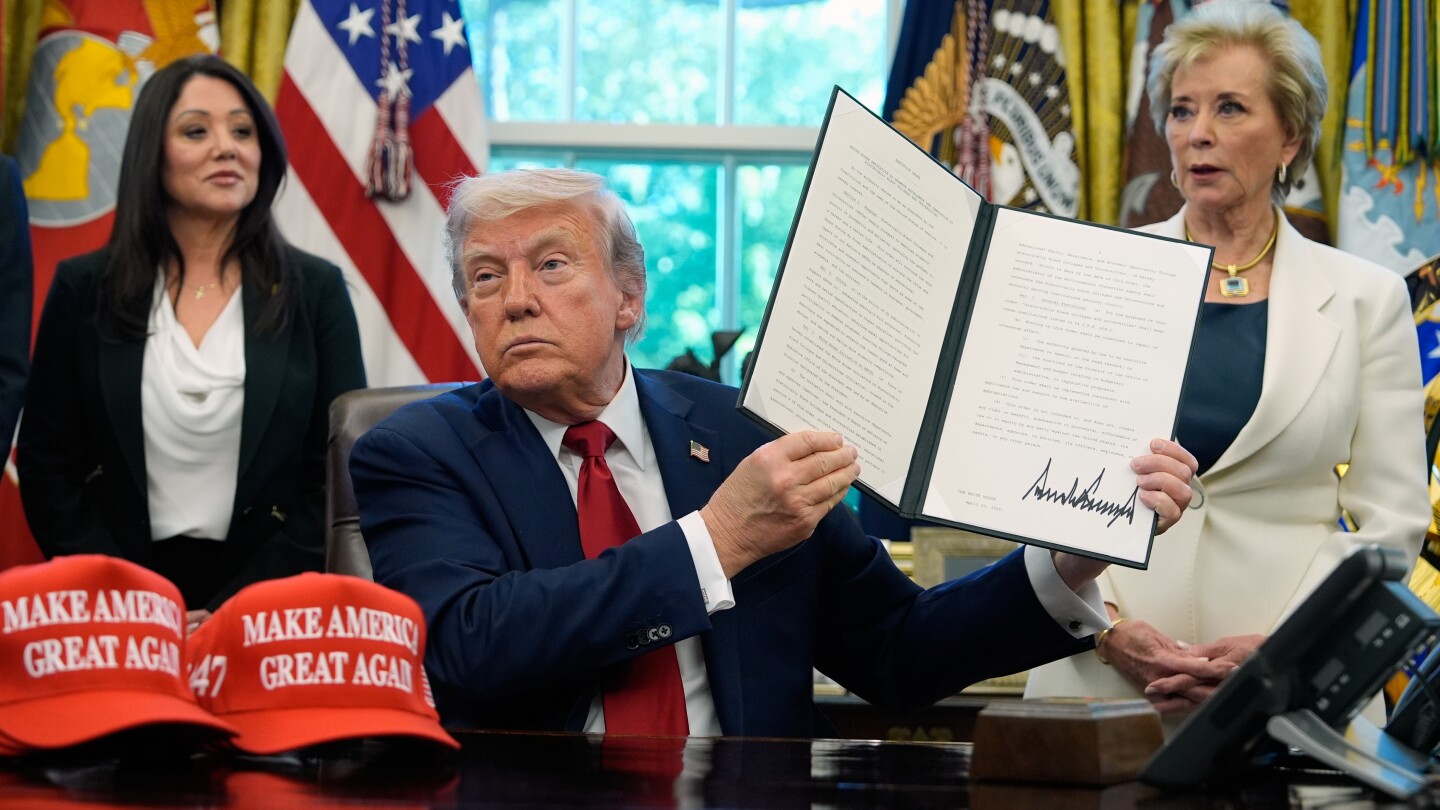Lifestyle
Trump’s executive orders target colleges like Harvard, DEI in education

WASHINGTON (AP) — President Donald Trump has ordered sharper scrutiny of America’s colleges and the accreditors that oversee them, part of his escalating campaign to end what he calls ” wokeness ” and diversity efforts in education.
In a series of executive actions signed Wednesday, Trump targeted universities that he views as liberal adversaries to his political agenda. One order called for harder enforcement of a federal law requiring colleges to disclose their financial ties with foreign sources, while another called for a shakeup of the accrediting bodies that decide whether colleges can accept federal financial aid awarded to students.
Trump also ordered the Education Department to root out efforts to ensure equity in discipline in the nation’s K-12 schools. Previous guidance from Democratic administrations directed schools not to disproportionately punish underrepresented minorities such as Black and Native American students. The administration says equity efforts amount to racial discrimination.
Foreign money is at issue in clash with Harvard
Colleges’ financial ties with foreign sources have long been a concern among Republicans, especially ties with China and other countries with adversarial relationships with the U.S. It became a priority during Trump’s first term and reemerged last week as the White House grasped for leverage in its escalating battle with Harvard University.
President Donald Trump is handed an executive order to sign by White House staff secretary Will Scharf in the Oval Office of the White House, Wednesday, April 23, 2025, in Washington. (AP Photo/Alex Brandon)
The White House said it needed to take action because Harvard and other colleges have routinely violated a federal disclosure law, which has been unevenly enforced since it was passed in the 1980s. Known as Section 117 of the Higher Education Act, the law requires colleges to disclose foreign gifts and contracts valued at $250,000 or more.
Last week, the Education Department demanded records from Harvard over foreign financial ties spanning the past decade, accusing the school of filing “incomplete and inaccurate disclosures.” Trump’s administration is sparring with Harvard over the university’s refusal to accept a list of demands over its handling of pro-Palestinian protests as well as its diversity, equity and inclusion efforts.
In the executive order, Trump calls on the Education Department and the attorney general to step up enforcement of the law and take action against colleges that violate it, including a cutoff of federal money.
The Trump administration intends to “end the secrecy surrounding foreign funds in American educational institutions” and protect against “foreign exploitation,” the order said.
It was applauded by Republicans, including Rep. Tim Walberg of Michigan, chair of the House Committee on Education and the Workforce. He accused China of exploiting academic ties to steal research and “indoctrinate students.”
Accreditors ordered to drop DEI
Another order aims at accrediting bodies that set standards colleges must meet to accept federal financial aid from students. Trump campaigned on a promise to overhaul the industry, saying it was “dominated by Marxist Maniacs and lunatics.”
President Donald Trump speaks with reporters after signing executive orders in the Oval Office of the White House, Wednesday, April 23, 2025, in Washington. (AP Photo/Alex Brandon)
Often overlooked as an obscure branch of college oversight, accreditors play an important role in shaping colleges in many aspects, with standards that apply all the way from colleges’ governing boards to classroom curriculum.
Trump’s executive order is the opening salvo in what could be a lengthy battle to overhaul the accrediting industry. Chief among his priorities is to strip accreditors of DEI requirements imposed on colleges. Some accreditors have already dropped or stopped enforcing such standards amid Trump’s DEI crackdown.
Trump’s order calls on the government to suspend or terminate accreditors that discriminate in the name of DEI. Instead, it calls on accreditors to focus more squarely on the student outcomes of colleges and programs they oversee.
The president wants to make it easier for new accreditors to compete with the 19 that are now authorized to work on behalf of the federal government. As it stands, new accreditors looking to be recognized by the government must undergo an arduous process that traditionally takes years. Trump’s order said it should be “transparent, efficient, and not unduly burdensome.”
“Instead of pushing schools to adopt a divisive DEI ideology, accreditors should be focused on helping schools improve graduation rates and graduates’ performance in the labor market,” Education Secretary Linda McMahon said in a statement.
De-emphasizing equity in school discipline
Trump also invoked opposition to equity efforts in his order on school discipline. The edict signed Wednesday seeks a return to “common sense school discipline,” allowing decisions to be based solely on students’ behavior and actions, McMahon said.
Another executive order instructs government agencies and departments to no longer rely on “disparate impact theories.” Under the disparate impact standard, policies and practices that disproportionately impact minorities and other protected groups could be challenged regardless of their intent.
President Donald Trump holds an executive order relating to education in the Oval Office of the White House, Wednesday, April 23, 2025, in Washington, as Commerce Secretary Howard Lutnick, Labor Secretary Lori Chavez-DeRemer and Education Secretary Linda McMahon watch. (AP Photo/Alex Brandon)
In many schools around the country, Black students have been more likely to receive punishments that remove them from the classroom, including suspensions, expulsions and being transferred to alternative schools. A decade ago, those differences became the target of a reform movement spurred by the same reckoning that gave rise to Black Lives Matter. The movement elevated the concept of the “school-to-prison pipeline” — the notion that being kicked out of school, or dropping out, increases the chance of arrest and imprisonment years later.
Federal guidelines to address racial disparities in school discipline first came from President Barack Obama’s administration in 2014. Federal officials urged schools not to suspend, expel or refer students to law enforcement except as a last resort, and encouraged restorative justice practices that did not push students out of the classroom. Those rules were rolled back by Trump’s first administration, but civil rights regulations at federal and state levels still mandate the collection of data on discipline.
On Wednesday, Trump directed McMahon to issue new school discipline guidance within 60 days. The order also calls for a review of nonprofit organizations that have promoted discipline policies rooted in equity and ensure they don’t receive federal money.
Another order creates a federal task force focused on giving America’s students training on artificial intelligence as early as kindergarten. It would work to develop new online learning resources.
Trump is also establishing a White House initiative to empower Historically Black Colleges and Universities. Among other efforts, it would seek to promote private-sector partnerships with HBCUs and schools’ workforce preparation in industries like technology and finance.
___
The Associated Press’ education coverage receives financial support from multiple private foundations. AP is solely responsible for all content. Find AP’s standards for working with philanthropies, a list of supporters and funded coverage areas at AP.org.
Lifestyle
One Tech Tip: Thinking of buying a secondhand phone? Some tips on what to look for

LONDON (AP) — New smartphones aren’t cheap and prices could reach even higher as globe trade tensions fueled by U.S. President Donald Trump’s tariff threats throw Asian exports into turmoil.
To save money, consider buying a secondhand device.
The market for used cell phones is booming. It’s now growing faster than the market for new devices, according to CCS Insight, a U.K.-based tech research firm.
As each new model release sends consumers rushing to upgrade, they’ll also be selling or trading in their existing devices, which usually have lots of life left.
If you’re on a budget, a refurbished secondhand phone can be up to 50% cheaper than new, and they now come with warranties, flexible financing and after-sales service, CCS said in a recent report.
Meanwhile, the starting price of a new top of the line iPhone Pro Max could potentially rise 29% from $1,550 to $1,200, according to a UBS estimate.
But buying a secondhand device is less straightforward than buying a new one. Here are some pointers:
Which phones are the most popular?
Apple fans will have the most choice because iPhones make up about 60% of the global market for secondhand phones, according to CCS insight. Samsung Android devices are second with about 17%. The rest is made up of lesser known Chinese brands like Xiaomi.
Where can I buy them?
There are numerous places online to buy secondhand phones, but like much of the internet, there are many scammers. The usual advice applies: check reviews, look for trusted sellers and guarantees, and avoid deals that seem too good to be true.
Try platforms that specialize in selling secondhand electronics and other goods such as Gazelle and Backmarket. Refurbished phones are also available from retailers like BestBuy and Amazon. Phone companies also sell them, so check with your wireless carrier.
Even Apple and Samsung sell secondhand devices on their websites. The advantage there is that they’ve been refurbished by their in-house technicians, so you’ll know they’ll be reliable. The downside is that discounts aren’t as significant and selection can be limited. Apple’s website currently only lists refurbished iPhone 13 and 14 models, for example.
When a phone is refurbished, it normally means that the data has been wiped and it has been tested and inspected for any problems. Any defective or faulty components are normally replaced.
A used phone, however, could refer to any secondhand device, including those sold by individuals through online classifieds like Facebook Marketplace. Prices could be cheaper but it’s buyer beware because used phones are often sold as-is and usually without any repairs or guarantees.
“You will get the best price if you’re prepared to handle that risk,” Simon Bryant, vice president of research at CCS Insight.
Lots of used phones are also sold on marketplaces for so-called peer-to-peer transactions that also offer better protections for buyers, like eBay or Swappa, which have policies for refunds if a phone isn’t as it was advertised.
What about the battery?
Just because a phone is refurbished doesn’t mean that critical components — especially the battery — have been automatically replaced. It depends on a vendor’s seller’s policies.
Apple and Samsung say their secondhand phones come with new batteries and, in Apple’s case, a new shell. Both companies also include a cable, a one-year warranty and a new box.
Meanwhile, other platforms might merely guarantee that a battery has a certain level of its original capacity, usually 80%.
How do I judge the quality?
There are ratings, but be cautious with the terminology.
Each secondhand platform will usually have its own system of grading the quality of the devices it’s selling. It’s a useful gauge for comparing various phones that the vendor has for sale.
But keep in mind there’s no universal system of grading. One platform’s rankings might, for example, read “Good, Very Good, Pristine and Like New,” while another will run from “Fair and Good to Excellent and Premium.”
Grading is “all over the place,” said Bryant, and it makes it difficult for consumers to compare, say, a $300 phone rated “Grade A” on one site with the same device on another site rated “like new” and priced at $280.
“It makes it difficult to shop around,” he said.
How old is too old?
Bryant advises buyers to look for a phone that’s about three generations old, and avoid anything that dates back more than five or six generations because that’s getting to the point where its Android or iOS operating systems may not be supported anymore.
Three generations is “the sweet spot,” said Bryant. “You know it’s going to work. It’s going to have relatively new features and it’s not going to be used so much. So the wear and tear on the device will be less.”
What about the risk that a phone is stolen?
Most online marketplaces have safeguards to prevent stolen phones from being sold to consumers, but check the policies to be sure.
If a phone is reported stolen, the carrier will usually blacklist the serial number, known as the IMEI number.
Swappa requires sellers to run their device’s serial number through its online checker before it can be listed for sale. The number can be found by dialing (asterisk)#06#. Some phones have two IMEI numbers, so Swappa advises checking both.
BackMarket says it works with the certified sellers that use its platform to make sure there are no blacklisted phones but sometimes “a bad apple” slips through. If that happens, it will work with buyers to return it immediately.
Can I check for water damage?
Most newer phones are water resistant and can withstand being dunked for a limited amount of time. But that doesn’t mean they’re totally waterproof. Any moisture that has gotten inside could damage components even if the phone looks fine from the outside.
If you’re buying a used phone in person, you can check if it has been exposed to liquid. Apple has a guide to finding the liquid contact indicator that every iPhone since 2006 has. Samsung has a similar page for Android devices.
What about accessories?
Charging cables or earphones might not be included. Don’t forget to budget for these.
___
Is there a tech topic that you think needs explaining? Write to us at [email protected] with your suggestions for future editions of One Tech Tip.
Lifestyle
Bluebells and other spring flowers are nature’s antidote to stressful times

HALLE, Belgium (AP) — Gilles Gui was looking for the magical purple bluebells that raise their heads each spring under the budding beech leaves of the Hallerbos forest, an annual explosion of color that draws crowds from around the world.
And in these times full of stress and anxiety about wars, economic threats and other tensions, he found something else too: a sense of tranquility.
“I notice that there’s a lot of silence in my head when I’m done,” Gui said. “Yeah, it helps me keep some peace in my mind, really just take my mind away from everything that’s going on.”
Spending time in nature, experts have long said, can be a balm in troubled times.
“From a stroll through a city park to a day spent hiking in the wilderness, exposure to nature has been linked to a host of benefits, including improved attention, lower stress, better mood, reduced risk of psychiatric disorders, and even upticks in empathy and cooperation,” a 2020 article of the American Psychological Association said.
“These are extraordinary times,” said Ignace Glorieux, a sociology professor at Brussels University, adding that the under-30 generation in particular is under pressure.
“This is also the generation maybe that suffered most from the COVID crisis,” Glorieux said. “And now they come into a situation where there’s a lot of international uncertainty. So especially this group, maybe more than (the older) generation, is suffering from that and feels very uncertain about their future.”
Gui, 26, knows what Glorieux is talking about. “I do know of people my age who are worried and also with financial situations going on, who try to keep level heads, but it’s very hard for them,” he said.
The bluebell woods offer a ‘big green hug’
During the pandemic, the bluebell woods were closed off for fear that throngs of people would make it a hive of transmission instead of a haven of peace. Restrictions kept some parks under seal and mandated masks in some others.
“It was a difficult period for everyone,” said Mark Demesmaeker, a former member of the European Parliament, gardening enthusiast and city councilor in Halle, where he has walked the woods for decades. Now, at least, nature is there to welcome those with anxious minds.
“These bluebells — but in other times of year as well, walking here, the forest valleys, the wildlife, the forest streams — you know, they work into your mind all year round. And it’s really a big green hug that you get here,” Demesmaeker said.
That hug from nature is just about everywhere right now. Japan is awash in a sea of cherry blossoms, which mesmerize people around the world. Bluebell season also coincides with the prime tulip season in the Netherlands. The renowned Keukenhof garden there has become a playground for influencers and those seeking that ultimate selfie.
Put down the phone?
The Keukenhof and the Dutch tourism board suggest good spots to “make your image come alive.”
To Glorieux, that’s where 21st-century humans push it too far.
“We have to be busy all the time, even in our leisure time,” he said. “We have to perform.”
Instead, he advised, “Focus! If you go out walking, focus on walking. If you go out jogging, focus only on jogging.”
Such advice was not wasted on Philippe Thiry, 64, a southern Belgian recently retired and ready to embrace the rest of his life. He had no phone as he set off in the sunshine to look for bluebells.
“I don’t want to use it here because I’m here just to relax,” he said. “I mean, just to see the flowers and to see, to listen to the birds.”
“I want to be disconnected.”
Lifestyle
New Orleans jazz festival celebrates music and food

NEW ORLEANS (AP) — The New Orleans Jazz and Heritage Festival kicks off on Thursday, bringing together a smorgasbord of the city’s most iconic homegrown artists for the next two weeks.
The festival, which draws hundreds of thousands of attendees, began in 1970 as a homage to the sounds of the birthplace of jazz and other genres with deep regional roots: blues, gospel, folk, Cajun zydeco and more. It now covers a wide range of music — headliners include Pearl Jam and Lenny Kravitz alongside hometown favorites like Lil Wayne — but remains focused on celebrating local artists and culture.
“We started out to reflect New Orleans to the world but now it’s just as much a part of New Orleans as Mardi Gras,” said Quint Davis, the festival’s longtime producer.
Davis also urges attendees to come hungry — the local flavors served up by festival celebrate the city’s renowned cuisine just as much as its music.
What’s the big deal about the food?
For some attendees, Davis says, the festival’s world-class musicians provide a soundtrack for their first priority: getting their hands on the delicious Cajun and Creole meals — from pheasant, quail and andouille gumbo to pecan catfish meunière and alligator sausage — served by local vendors.
Most of the nearly 70 different vendors have been part of the festival for several decades and “perfected their craft,” said Michelle Nugent, the festival’s food director.
“The menu we feature you can’t find anywhere else,” Nugent said. “Everything is handmade and home-cooked.”
Robert Harrison III carries on the legacy of his late mother’s bakery, Loretta’s Pralines, which sells chocolate, rum and coconut pralines, along with a fan favorite that mixes pralines with a deep-fried dough pastry known as a beignet.
“The praline beignet — my mom was a genius for this: she took two New Orleans products that were just so French and she mashed them together,” Harrison III said. He and his staff have spent weeks preparing thousands of pralines for the festival: “It’s something that you have to love to do — my Mom loved to do it and we do too.”
Another Jazz Fest offering to drool for is the Cochon de Lait Po Boy — suckling pig slow roasted on French bread — prepared by Walker’s Southern Style BBQ.
“We dry rub all those pork butts every night and they smoke all night long,” said Shayne Brunet, whose family has operated a stall at the festival for more than two decades. They add fresh coleslaw for crunch and the family’s secret “wertie” sauce — what Brunet describes as “Creole creamy” — for a sweet kick.
“One thing you won’t find there is burgers, hot dogs, pizza, French fries, any of the normal food that you can get any other festival type of place,” said John Caluda, who runs a baking shop and pioneered the crawfish strudel, a festival mainstay that wins over skeptics with its contrasting, flavorful textures.
The strudel joins the pantheon of festival originals beside local chef Pierre Hilzim’s “Crawfish Monica” a creamy pasta dish featuring crawfish tail meat and named after his wife. It’s become one of the festival’s most popular dishes and Hilzim says he requires nearly two million crawfish to satiate the appetites of festival customers.
“To be able to put a dish in the lexicon of food in this city — I’m very humbled by that,” Hilzim said. As for attendees of the festival: “I don’t think anywhere in the world is eating better food.”
Who is playing at Jazz Fest this year?
Headliners at the festival include Pearl Jam, Lenny Kravitz, Dave Matthews Band, Luke Combs, Kacey Musgraves, Santana, Burna Boy and Lil Wayne and The Roots.
The majority of the dozens of artists playing over the course of eight days across 14 stages are native New Orleanians — Lil Wayne among them — such as Trombone Shorty, Big Freedia, Irma Thomas, Harry Connick, Jr. and Mardi Gras Indian leader Big Chief Monk Boudreaux.
This year’s festival poster features local band Tank and the Bangas, whose album “The Heart, the Mind, the Soul” won a Grammy earlier this year for Best Spoken Word Poetry Album.
Lead singer Tarriona “Tank” Ball, who grew up on a street called Music, first performed at the festival as a member of her high school choir. Even after touring around the world, she says there’s nothing like performing for her city.
“When it comes time to be at home for Jazz Fest, everybody just wants to give a little extra magic to the show,” Ball said. “You want to make it extra special because your auntie is out in the crowd, your little cousins — cause it’s home.”
She’s also looking forward to the festival food — her family runs a fried chicken and jambalaya stand, and Ball says they’ll have a plate saved for after her show.
___
Brook is a corps member for The Associated Press/Report for America Statehouse News Initiative. Report for America is a nonprofit national service program that places journalists in local newsrooms to report on undercovered issues. Follow Brook on the social platform X: @jack_brook96.
-

 Education19 hours ago
Education19 hours agoHarvard’s president says the school will ‘not compromise’ on its rights with the Trump admin
-

 Sports1 day ago
Sports1 day agoLA Lakers level first-round series against Minnesota Timberwolves behind big Luka Dončić performance
-

 Middle East1 day ago
Middle East1 day agoMagnitude 6.2 earthquake jolts Turkiye’s Istanbul | News
-

 Lifestyle1 day ago
Lifestyle1 day agoWorries about flying seem to be taking off. Here’s how to cope with in-flight anxiety
-

 Lifestyle1 day ago
Lifestyle1 day agoWinemakers in New York Finger Lakes embrace sustainability amid climate change
-

 Middle East1 day ago
Middle East1 day agoYemen’s Houthis launch rare missile attack on northern Israel | Conflict News
-

 Conflict Zones1 day ago
Conflict Zones1 day agoManhunt under way in Kashmir after deadly attack on tourists | Conflict News
-

 Lifestyle1 day ago
Lifestyle1 day agoNFL draft suits give prospects another way to cash in on their fame, flash their style on red carpet




